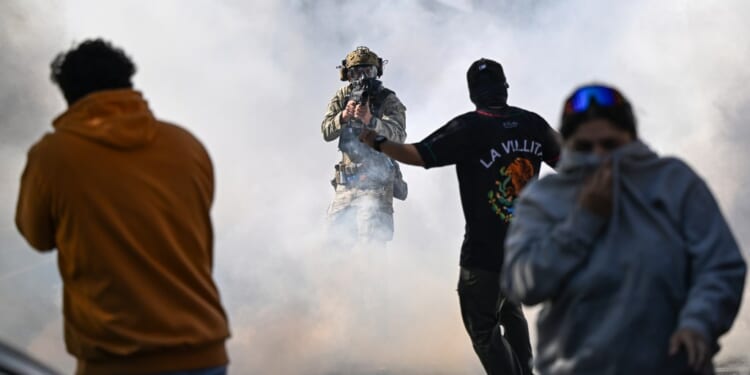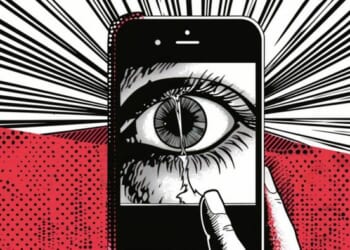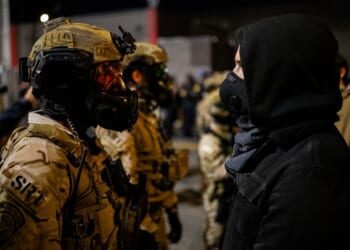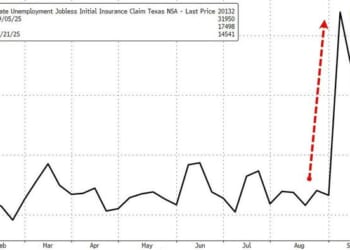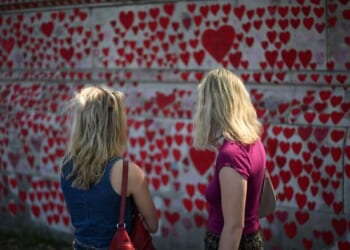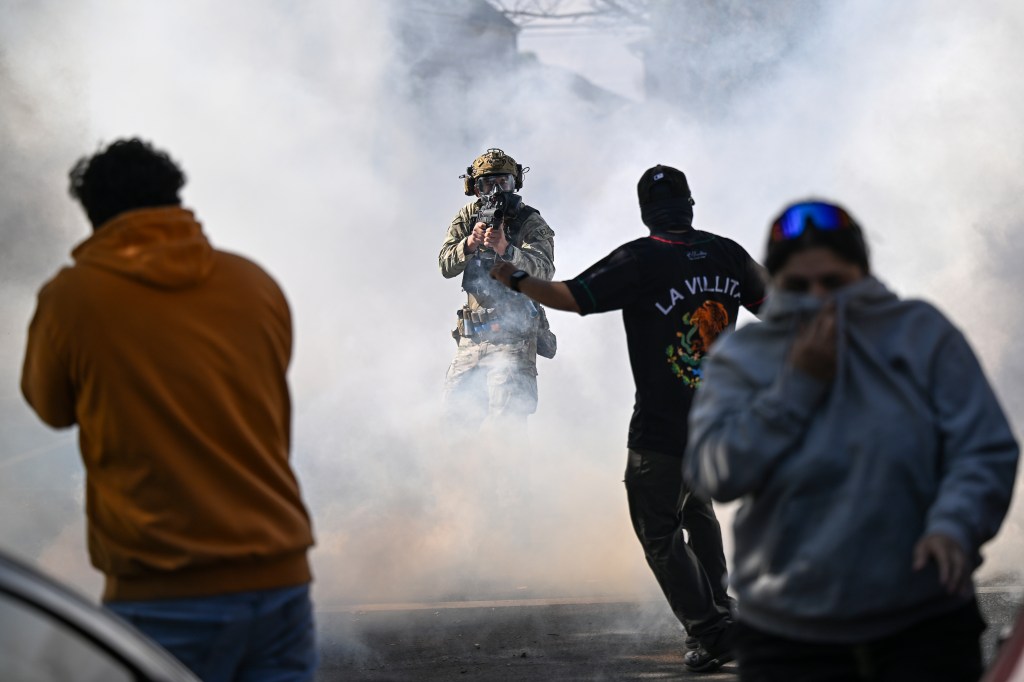
CHICAGO—The Department of Homeland Security announced on September 8 it was starting to “target the worst of the worst criminal illegal aliens in Chicago” in a stepped-up campaign of immigration enforcement the Trump administration had dubbed “Operation Midway Blitz.”
Hearing those two words together—Midway and Blitz—is more than a bit odd to anyone with a passing familiarity with World War II: Midway was the turning-point battle for the Americans in the Pacific, and Blitzkrieg was the German word for the Wehrmacht’s style of “lightning war.” Midway is, of course, also the name of the airport in southwest Chicago, near heavily Latino neighborhoods where Immigration and Customs Enforcement (ICE) agents have targeted operations.
When I tell the Uber driver who picks me up at Midway I’m in Chicago to cover ICE’s efforts to deport illegal immigrants, the 71-year-old driver, who emigrated from Greece as a teenager, replies: “They cause a lot of problems. I hope that they get them.”
“They tried to carjack my car,” he says. How’d he know the criminals were illegal immigrants? “It was gangs. I don’t know if it was illegals,” he replies, before telling me which neighborhoods he avoids so he can live to see his grandkids.
But six weeks into Operation Midway Blitz, it’s not clear how many violent criminals ICE has nabbed. DHS Assistant Secretary for Public Affairs Tricia McLaughlin told The Dispatch the operation had resulted in about 1,500 detentions as of this week, but she did not reply when asked how many of those 1,500 had criminal records unrelated to entering or staying in the country illegally. When DHS released a press release on October 3 announcing there had been 1,000 detentions, it highlighted just 10 detainees who had criminal records.
“You see them conflating constantly this issue of illegal immigrants and violence in the city,” Dan Lipinski, a former Democratic congressman from Chicago, told The Dispatch. “What’s going on now is not doing anything about crime in the city. I doubt it had any impact whatsoever.” Even if the true objective is mass deportations, Lipinski noted 1,500 detentions represent a “small little dent” in the total estimated population of 425,000 illegal immigrants in Illinois.
What many local residents say the operation has produced is a climate of fear and confusion in the city. Inside La Catedral Cafe in Little Village—a vibrant and predominantly Mexican-American neighborhood—the restaurant, adorned with scores of crucifixes on the walls, was bustling around lunchtime this past Tuesday. But patrons said those appearances were deceiving. “Our friends didn’t want to come [to lunch] because they’re Hispanic,” Yolanda Ramirez, a U.S. citizen who immigrated from Mexico, told The Dispatch. “Even though they’re born here, people are worried just because … they look Mexican.”
“Everybody’s just scared about the whole thing,” Tina Avalos, also a U.S. citizen who immigrated from Mexico, told The Dispatch. She said her niece, an American citizen, had recently been followed by ICE agents simply for recording their activities with her cell phone.
Maria Orozco, who works for the Street Vendors Association of Chicago based in Little Village, told The Dispatch that “80 percent of our vendors aren’t out selling. And if they are selling, they’re not making any profit like they used to.” She recounted the story of one vendor named Alejandro, who was picked up by ICE while selling elotes last week and deported to Mexico after living in Chicago for 20 years. “Small local businesses are struggling getting people through the door. People don’t want to go out,” Orozco said.
The Trump administration’s bait-and-switch—claiming to target violent criminals and gang members while in reality focusing on deporting nonviolent illegal immigrants—has already cost the president the support of some of his allies. “I really thought they were just going to go after the criminals,” popular podcaster Joe Rogan, who endorsed Trump in 2024, said on his podcast last week. “I really thought there was enough gang members.” Rogan said that targeting otherwise law-abiding illegal immigrants who have been here for decades “shows no heart, and that’s the problem. You’re not going to get any reasonable people to want to go along with that.”
And the fears of U.S. citizens being detained aren’t without basis. The Chicago Tribune reported on October 13 that a U.S. citizen named Maria Greeley said she was stopped and zip-tied before being questioned by ICE agents after finishing a shift at a bar in Chicago. Greeley said she was carrying her passport, but agents told Greeley, who is adopted, that she “doesn’t look like” a Greeley. DHS did not reply to an email from The Dispatch asking if it disputed Greeley’s claims.
“Tensions are extremely high, and it’s a very unhealthy information environment,” Austin Berg, executive director at the Chicago Policy Center at the Illinois Policy Institute, told The Dispatch. “That unhealthy information environment, I think, has been worsened by, in some instances, the federal government, in some instances local media, in some instances local officials.”
The biggest problem with information from the federal government, Berg said, was its unreliability. For example, Berg pointed to a recent video of ICE agents detaining a U.S. citizen named Debbie Brockman. DHS said she was detained for throwing objects at ICE agents—which Brockman and her attorneys deny—but she was released without charges. “So what does that fact pattern leave people with? They don’t know what’s true,” Berg said.
In another instance, a video appeared to show a federal agent aggressively detaining a young woman in the Chicago suburb of Hoffman Estates, but DHS Assistant Secretary McLaughlin tweeted that the video was “from a burglary arrest Chicago Police made over a year ago. This isn’t even ICE.” But the parents of the 18 year-old-woman, a U.S. citizen, spoke to local news and said their daughter had been detained by ICE and released without charges after videotaping ICE activities. Hoffman Estates police issued a statement confirming ICE activity in the area. Asked if she was mistaken about her claims about this video, McLaughlin did not reply to an email from The Dispatch.
Yet, some local activists have inflamed tensions with their own rhetoric and actions. “Use your cars. Block the parking lot. Don’t let them leave with your neighbor,” one activist wearing a Chicago Teachers Union shirt said at a recent anti-ICE event organized by a local Chicago alderman. “Make their lives a living hell.” (An attendee at the event told The Dispatch the activist introduced himself as a music teacher.)
There have been instances of individuals ramming the vehicles of ICE agents in Chicago, but given the DHS’s difficulty with the truth, it’s hard to know how many of those incidents played out as DHS officials have claimed in the absence of video evidence.
The confrontations between federal agents and Chicago residents—as well as three separate shootings targeting immigration officials in the state of Texas this year—have increased the possibility that President Donald Trump could invoke the Insurrection Act to deploy the U.S. military to Chicago. “We have an Insurrection Act for a reason,” Trump said on October 6. “If people were being killed and courts were holding us up, or governors or mayors were holding us up, sure, I’d do that.”
Trump’s attempts to federalize National Guard troops and deploy them to Chicago are currently held up in federal courts, but as Harvard Law professor Jack Goldsmith has written, the president has far greater legal latitude to use the Insurrection Act. That law gives the president the power to deploy the military inside the United States when “the President considers that unlawful obstructions, combinations, or assemblages … make it impracticable to enforce the laws of the United States.”
Despite the broad power given to the president, political norms have resulted in it being rarely invoked in the modern era. It was last used by President George H.W. Bush, with support from California officials, to restore order to Los Angeles during the 1992 riots, and before that it was used to enforce desegregation in the South.
Local Democrats who have been willing to break with their party are nevertheless urging Trump not to invoke the Insurrection Act. Paul Vallas, who lost the 2023 Chicago mayoral race to Brandon Johnson, has been sharply critical of Johnson for his aggressive policies making Chicago a sanctuary city for illegal immigrants. But Vallas told The Dispatch: “I don’t think the National Guard should be deployed. … God forbid, sending in the Marines. That’s ridiculous.”
“I don’t see the purpose of that,” Dan Lipinski, who was purged from the Democratic Party over his opposition to abortion, said of the Insurrection Act. “I think it would backfire. I think it would not be helpful in any way whatsoever to Trump. … The whole thing concerns me much more than I was ever concerned in the first Trump term.”
Some local activists told The Dispatch they’re trying to make it as clear as possible that they’re peaceful to deny Trump any excuse for cracking down on Chicago. The ICE detention facility in the Chicago suburb of Broadview has been the site of confrontations between activists and federal agents—a Presbyterian pastor was shot in the head with pepper balls on September 19—but when The Dispatch visited the facility on Tuesday afternoon, fewer than a dozen protesters were on site, including two dressed up in inflatable animal costumes. “It represents that we are nonviolent, and it also pokes fun at powerful men,” said Dean Kapolas, who was wearing an inflatable yellow duck costume. A woman named Lee, who declined to share her last name and was dressed in an inflatable dinosaur costume, told The Dispatch: “When Trump talks about the city being on fire, you can see us two Antifa super-soldiers here in our battlegear.”

